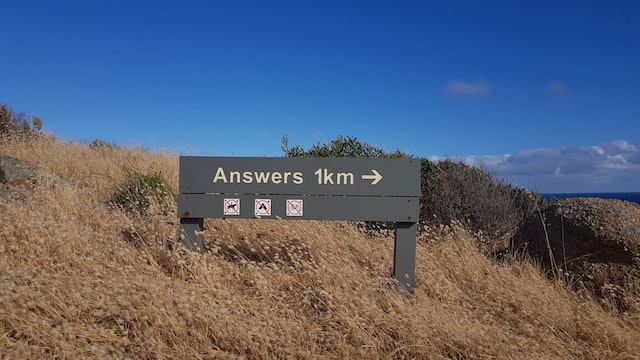What is Question Storming?
Question Storming, sometimes referred to as Question Burst, is an effective method to generate solutions for a team problem.
To understand the effectiveness of the approach, we must first look at why problems are not being solved and for what types of problems the Question Storming method is worthwhile.
Simply put, there are two reasons why a problem is not solved:
1. it is an unsolvable problem such as some mathematical problems are (a prominent example is squaring the circle)
2. the problem solution fails within the problem solving process.
This can happen in all four phases – the problem phase, the solution phase, the decision phase, and the implementation phase.
Question Storming effectively prevents us from moving a problem too quickly into the decision and implementation phases. It thus supports us in the problem and solution phases. We will take a closer look at how this works in the following.
First, an important note:
Sometimes it happens that many questions are generated in a Question Storming about a problem that, in retrospect, should not be in focus at all. This is because the problem is either
- too narrowly defined or
- too broadly defined
by the manager or workshop facilitator.
An example of both types of wording:
- “How can we manage to sell our products successfully?”
(broadly worded). - “How can we manage to successfully sell product X in market Y in time period Z” (narrowly formulated).
From my experience, the Question Storming method can be used successfully for both cases, but it should be clearly communicated in advance which problem will be addressed in the meeting.
If the problem definition is too narrow, Question Storming can quickly become a classic case of “great input, lousy output”.
If the problem definition is too broad, there is a risk that the questions that arise will become very general. This usually significantly reduces the added value for the recipients.
However, both potential dangers can be well controlled by professional workshop moderation.
 Start with Questions
Start with Questions
Question Storming: Great input, great output
We assume here that the manager and the team know exactly what the problem is. If this is the case, Questioning Storming can be used effectively in the problem-solving process. All you need to consider for this are five simple steps:
Step 1: Communicate the objective of Question Storming
Step 2: Make the rules and steps of Question Storming transparent.
Step 3: Introduce the problem definition
Step 4: Record the questions in the individual rounds and keep a record of them
Step 5: Prioritize the questions
Step 6: Determine the next steps
Step 1: Communicate the objective of the Question Storming
The leader or workshop facilitator starts the Question Storming process with a brief introduction to the purpose.
The purpose of this method is to optimize the solution finding process. Through Question Storming we want to avoid looking at the problem with the same glasses over and over again and thus working out conventional solutions. And we also want to avoid forgetting or overlooking important aspects of a problem. Question Storming helps with both by encouraging problem solvers to look at a wide variety of things. We’ll look at what that can be in an example in a moment.
Step 2: Making the rules and steps of Question Storming transparent
Next, the workshop leader first introduces the three unique and important rules of Question Storming:
1. only questions are allowed and no answers, suggestions or recommendations.
2. the questions must be directly or indirectly related to the problem.
3. questions must be formulated and recorded in a non-judgmental manner and no reactions or evaluations to the question are allowed with the exception of further questions.
The workshop leader then presents the five individual steps of question storming. Potential questions from the participants can be clarified at this point. For the transition to step 3, it should be clarified in advance whether this step will be taken over by the workshop leader, the executive or a specific “problem owner”.
Depending on the topic, the time available, the type of participants and the preferences of the executive and the team, a basic process can be carried out in Step 3 or a more specialized form. I present my favorite variation below, while also explaining the basic process.
Step 3: Introduce the problem
At this point, the problem statement enters the room.
The participants of the Question Storming round are allowed to ask comprehension questions about the problem at this point, if there are any. The person who explained the problem statement is allowed to introduce any questions at this point.
Then the first of three rounds of questions begins.
Step 4: Collect and record the questions in the individual rounds
Question round 1: Questions in a circle – the basic process
In a circle, all participants of the Question Storming meeting can formulate a question that they would like to ask in relation to the problem. The workshop facilitator takes all questions and writes them down – preferably on digital or analog facilitation cards.
The first round of questions continues until no new questions come from the round.
Leaders and teams who like it very structured can design the basic process of Questions Storming in such a way that the type of questions are pre-scripted by different question words. Here, it is a good idea to pre-set the following 11 questions as the start of a question:
1. what-question
2. how-question
3. who-question
4. where-question
5. when-question
6. with what question
7. where-question
8. which-question
9. whose-question
10. how much question
11. if-question
 Question Storming for strategic direction
Question Storming for strategic direction
Without these guidelines, other questions are also allowed, but it is advisable for the moderator to intervene if the questions deviate too much from the original problem or are asked with a suggestive or judgmental undertone. It is also important for the workshop leader to intervene if negative and derogatory comments occur in response to individual questions.
Question round 2: Bad Cop and Good Cop questions – prioritization
After the first round, the workshop facilitator asks the person who was provided with questions from the round of participants to pick out the three currently most valuable questions. These will be focused on one after the other in the following. For this purpose, the participants of the Question Storming now form two teams. One team, consisting of “Good Cops”, has the task of looking positively at the focus question. The other team, consisting of “bad cops,” has the task of critically examining the focus question.
Only questions are still allowed as feedback. The teams each take turns asking their question and the round ends when there are no further questions on any of the three focus questions from either team.
Question round 3: Squeezing the lemon – the key question
After the second round, the “problem solver” is given the task of breaking the topic down to the one, most essential question that is currently important for proceeding further.
The question is then given to the circle of Question Storming participants for a final third round. They may now contribute further questions one last time without being assigned to a team.
Step 5: Prioritize the questions
If you carry out Question Storming in the basic process, you should prioritize the large number of questions in step 5. There are various methods for doing this, depending on whether the collected questions were directed at a single person – for example, the manager or a team member – or at the entire team.
If the questions are addressed to one person, this person should also do the prioritization and focus on the maximum of five (preferably three or fewer) most important questions.
If the prioritization is to be done from within the team, one possibility is to assign points. For this, all persons involved in the Question Storming get 10 points, which they distribute to the individual questions according to their own preference in the virtual or real room. The questions are then sorted according to the number of total points they received.
In my variant of Question Storming presented in step 4 above in the text, the prioritization was already done between question rounds 1 and 2 as well as 2 and 3.
Step 6: Determine the next steps
After the individual Question Storming rounds and prioritization, there are usually some valuable questions, which in turn raise a crucial question:
Where do we go from here?
At this point, the manager is asked, either independently or in consultation with the workshop facilitator, to translate the output in the form of one or more prioritized questions into concrete tasks with a time frame.
This is followed by a short summary with thanks to the participants to end the Question Storming.
 In Question Storming answers are for later
In Question Storming answers are for later
Question Storming Case Study:
90min Question Storming with a hidden champion from the automotive supply industry.
A customer in southern Germany wanted to use a workshop format to address the problem that sales figures had been declining for several quarters.
The customer identified the decreased demand for their top product as the main problem. The reason for the declining demand was the overarching change in the industry away from the internal combustion engine to more electromobility and alternative drives from renewable energies.
The statement of the responsible sales manager “We need an answer here as quickly as possible to reverse the trend” rather indicated an “answer storming”, but this approach had not brought in satisfactory results so far.
So now a moderated Question Storming workshop on a sunny morning.
In less than an hour, 91 questions were already hanging on the wall, including:
1. what would our customers advise us to do?
2. how can we realign our core competencies?
3. who else could support us in the change?
4. where is our expertise needed?
5. when would we have missed the opportunity?
6. what already makes us competitive in the e-suppy chain today?
7) Where are the requirements of our main customers currently developing?
8. which suppliers are bringing us forward technologically?
9. whose problem do we want to solve?
10. how much potential does the market have?
11. if we would not look at the sales development for eight quarters,
what would we decide today?
Question Storming is not about getting into the technical or business details already. Therefore, the executive explained the importance of doing this over the next six weeks and doing a “deep dive” for the following three questions:
1. where are our key customers’ needs going?
2. what problem are we trying to solve?
3. who else could support us in the change?
A cross-functional team from corporate development, sales and purchasing was set up to further address these three questions derived from the question storming.
Six weeks later, a presentation was made to the board. This presentation resulted in some far-reaching decisions and reorganizations.
Some two years later, the company has set a new sales record and is heading for fantastic annual results.
The extent to which Question Storming generated the decisive impetus for rethinking here is probably a subjective assessment.
What counts for me is that the method is very positively received by most customers and is seen as effective and broadening their perspectives.
What is made of it is then up to the customer himself. True to the coaching principle:
“The responsibility remains with the customer throughout the entire process”.
I wish you much success and joy with your next Question Storming!
ps: Are you interested in experiencing the effect of a professional Question Storming in your team? Write me an email (antoni@3a-coaching.de) or use the contact form for your inquiry.
More articles
by Antoni

How to reach your goals with CORE Questions
When it comes to personal and professional development, the CORE questions have emerged as a powerful tool for self-reflection and goal-setting. These four fundamental inquiries—Challenge, Outcome, Resources, and Effect—provide you with a systematic approach to show you the way from problem focus to goal focus.
By delving into each aspect, you can gain more clarity, define your objectives, mobilize your resources, and evaluate the impact of your actions. In this blog post, we will explore the significance of the CORE questions and how they can guide you towards accomplishing your aspirations.
by admin

Questioning Techniques: How to use SPIN Questions
Questioning techniques are an essential element in my coaching kit. Today I am therefore starting the ABC of Questioning Techniques, in which further questioning techniques will follow in the coming weeks. Let's start with the SPIN questions - SPIN stands for situation questions, problem questions, implication questions and benefit questions. In this blog post you will find out where SPIN can help you and how it works in a sales meeting with a client.
Read more … Questioning Techniques: How to use SPIN Questions
by admin

How to solve team conflicts in seven steps
I often come across ongoing conflicts in teams of all kinds. And while a certain amount of conflict in the team can contribute to the achievement of goals, some conflicts develop in a destructive direction. Both openly acted out conflicts as well as hidden and subliminal conflicts then inhibit cooperation and thus also the quality of results in day-to-day business or in projects. In this blog article, I explain my method for effectively resolving conflicts in the team.
by admin

What we can learn about ourselves from moral licensing
Today we are talking about the psychological phenomenon of moral licensing. In the following, you will learn what it is all about and how I assess the different types.
Read more … What we can learn about ourselves from moral licensing
by admin

Question Storming - how the method works best
Today's blog article is about Question Storming - one of my favorite methods in workshops. Unfortunately, the method is often used incorrectly and thus does not reach its full potential. In this article you can read how you can do it better in your organization and your team.
by admin

Leadership live webinar
Today I'd like to introduce you to my regular live webinar for people in leadership positions on the topic of " solving problems effectively". In this article you can find out what the webinar is about, what's the added value for your, why I'm holding it live and how you can register.
by admin

Four approaches to a happy life
Today we are dealing with a classic question that many well-intentioned and poorly made guidebooks unfortunately come up with. The question of our own satisfaction and how we can best achieve and maintain a "happy state". Here we go...
by admin

How a Coaching in India broadens your horizon
Today I share my latest international coaching project with you.
20 coaching sessions with different people from India. In this article I will share my thoughts on why I highly recommend everyone to get exposed to a completely different environment than the one you are used to, both privately and professionally.
by admin

How to solve problems with perspective changes
Today let's take a look at a popular tool that you can expect to find in every good coaching toolbox - change of perspective. I will go into what the change of perspective is all about, how you can make the best use it for yourself and how a "cerebral cinema" for two practical examples looks like.
by admin

Successful investments using the mountain metaphor
Today we are talking about investing money in the stock market. And specifically about the emotional challenges of investing money. This aspect is often underestimated - which is why this article teaches you what shouldn't happen to you and your investments on the stock market. Of course, this is not investment advice, but only my personal opinion as a private investor and coach.
Read more … Successful investments using the mountain metaphor
by admin

How we can learn to make the best decisions
We make several thousand decisions a day - which is quite a lot, in fact. We make most of them without any significant cognitive effort, virtually automatically. Other decisions are the result of thorough analysis and thoughtful evaluations. And sometimes we postpone decisions to infinity. In this blog post you can find about out what we can learn from our decision-making styles and you'll find some specific examples from the world of professional sports (Golf and football/soccer)...
